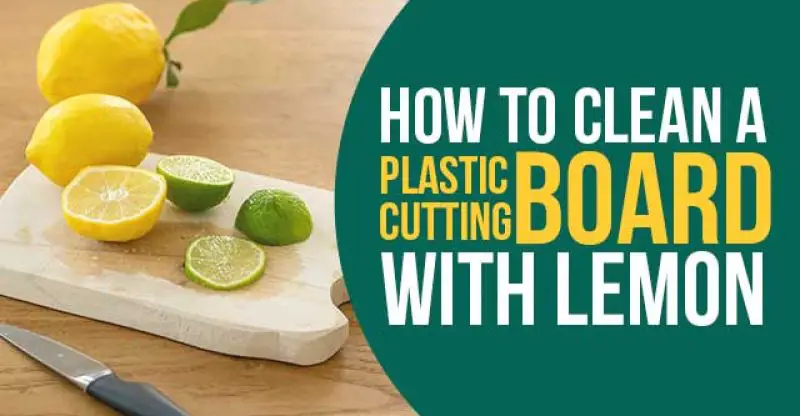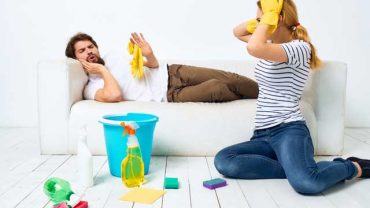How to Clean a Plastic Cutting Board with Lemon
Cutting boards made of plastic can make your life easier in the kitchen because they’re easy to store and clean, but as any chef knows, cutting on plastic can dull your knives quickly and make them harder to use.
Many cooks choose to clean their plastic cutting boards with soap and water, but this can leave behind unhealthy bacteria that can lead to food-borne illnesses.
Fortunately, there’s an easy way to clean your plastic cutting board that involves one of the most versatile kitchen ingredients out there: lemon juice!
Steps in Cleaning Plastic Cutting Boards
- Rubbing Lemon on the Plastic Cutting Board
- Scrub the Cutting Board with a Brush
- Washing the Cutting Board in Water
- Rinsing and Drying the Cutting Board
Lemon juice is a healthier alternative that will cut through grease and kill bacteria without adding toxic chemicals to your kitchen.
1. Rubbing Lemon on the Plastic Cutting Board
There is an easy way to clean your plastic cutting board. Just rub them well with some fresh, squeezed lemon.
The citric acid in lemons naturally breaks down stains and will not harm even non-stick surfaces. In addition, it leaves no sticky residue behind and leaves your kitchen smelling fresh.
If you are lucky enough to have one of those germ-free plastic ones, don’t use any other cleaning agent on it besides lemons. Salt or vinegar might work for stainless steel or glass, but these may also damage a germ-free plastic surface if they are too abrasive.
2. Scrub the Cutting Board with a Brush
To clean away grime and food particles, it’s important to brush your cutting board. You can either do so manually or with an electric scrubber, which is faster and more efficient.
Rinse off all traces of soap: Once you’ve brushed your cutting board, run it under running water and make sure no soap residue remains on its surface. With lemon juice: Cut up half a lemon into wedges and coat your cutting board in their juices.
3. Washing the Cutting Board in Water
Plastic boards should be washed in water and scrubbed with hot soapy water, but not put through an automatic dishwasher.
The best way to sanitize your cutting board is by washing it in warm, soapy water and then dipping it into boiling water for 10 minutes.
If you don’t have time for that, at least run some extra hot tap water on your plastic board before cooking anything on it.
Once you’re done using it, give it another good wash you don’t want bacteria hanging around. Sanitizing plastic cutting is especially important if you will be sharing your boards or using them when camping or traveling.
4. Rinsing and Drying the Cutting Board
The easiest way to clean most surfaces, including cutting boards, is just by rinsing them off under warm running water.
Soak wooden boards in some warm water with soap, and then use a sponge or dishcloth to scrub them down. To sanitize wood, soak it in an all-natural bleach alternative like vinegar or peroxide for 5 minutes. Allow it to air dry completely before you put food on it again.
If your plastic or polyethylene cutting board starts looking dingy and worn out (and we’re talking dull, not cracked), you can scrub away any stains or residue by applying undiluted lemon juice directly onto that spot and letting it sit for 30 minutes before rinsing thoroughly.
Bottom Line
Plastic is extremely tough, but it’s also porous. This means that there are tiny holes in your plastic cutting board, and they let nasty stuff like bacteria grow inside.
Don’t want your food or dishware to get contaminated? Give your plastic boards a good wash every now and then. You can use soap and water if you want, but since that could cause you to miss any tiny holes in your boards, I recommend using lemons instead.
FAQs
Don’t worry, we have you covered. To start, wipe down your plastic cutting board with a damp sponge or cloth that has been dipped in lemon juice. If you have time, set your cutting board outside on a hot summer day so that it can soak up some of the sun’s rays. The heat and lemon juice should cause any unsightly stains to fade quickly. If you don’t have time for that, no worries.
To answer that question, we must first define disinfecting. Disinfection is not sterilization, though sometimes people use these terms interchangeably. While disinfectants can kill harmful organisms and inactivate their infective potential, they do not always eliminate all living forms of an organism. In most cases (with some exceptions), sterilization is required for the complete elimination of all living organisms, including bacterial spores that may not be affected by disinfectant activity.
Cleaning a plastic cutting board isn’t nearly as difficult as you might think. It does take some elbow grease, but you don’t need any harsh chemicals or cleaning products (and definitely no bleach). I love my plastic cutting boards, and always make sure that I clean them properly before putting them away.
It sounds like an old wives’ tale, but cleaning plastic cutting boards is easy as can be: All you need is lemon. The acidity of lemons breaks down residues and oil on your board in no time. Just rub it on, rinse it off, and throw it in the dishwasher when you’re done. It couldn’t be easier! We have more cooking tips and recipes for your healthy lifestyle here.



